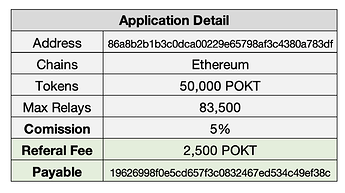Attributes
Problem
Despite the ongoing efforts to reduce the network costs and create a less volatile economic environment for node runners, a key variable has been left under emphasised: demand-side growth by brining more paid applications and clients to the network.
Currently, there is no direct incentive for community members to grow the number of relays in the network by increasing the project’s exposure in different regions; rather, the only economic incentive is to run nodes and increase the supply side of the network’s infrastructure. The community should not rely on the core team for all business development; it should take on some responsibility to develop key business areas.
Proposal
- Creation of a Referral Program within the new Monetised Client Portal
- 5% Commission paid to Community Members who Refer Self-Staking Clients
- Commission paid as percentage from the Total Self-Stake Amount paid in the Portal by Applications
- Commission is only payable if it resulted in a paid-client acquisition
Example
Alignment with App Staking Proposals
There are currently 4 options being explored to monetize the Portal, as per the Infracon presentation. We believe the commission model should be applied to the initial payment made by the application client, and not on any continuous monthly subscription arrangement made with the client. This makes it subject to the following options:
- B.Y.O. POKT and Stake Directly
- Direct on-ramping within the Portal
- Wrapped POKT Stake
- The initial month’s subscription payment.
Benefits of Proposal
- Growth of Application Count within Pocket from Supported Chains,
- Growth of Total Relays going through Pocket,
- Regional Incentivization of Business Development,
- Increased Community Engagement and Responsibility,
- Leveraging Community Connections to grow Customer Base,
- Increasing Business Development Outreach to new Regions,
- Greater Distribution of Network Traffic within Applications,
- Reduced Cost per Client Acquisition for the Network,
- Better Reputation and Recognition in the Web3 Ecosystem.
Analysis of Counterpoints
-
It will become more expensive for clients to onboard within Pocket.
We believe the proposal will result in the community onboarding far more applications than the resultant loss of perspective clients arising from the additional 5% expense. This is a common business practice that we weigh as having a far greater net-positive economic impact. -
It adds development work to the Portal
Yes, but we feel this is the right time to be having this conversation as the Portal is still under construction. We believe the investment from a resources point of view is minimal in relation to the potential benefits. -
There is no classification of lead quality within this proposal
It is true that in this model, we fear there is no further incentive for bringing high-quality leads as opposed to just a large volume and hopping the core team can close them. In order to tackle this, we believe the referral program should have a template application that pre-qualifies the lead. The community should perform the basic workload of explaining the project’s comparative advantages, answering key questions and only bring attention to the core team once enough interest is displayed. By having a referral program document that needs to be submitted, we can outline the criteria before prospective clients are connected to the technical team.
